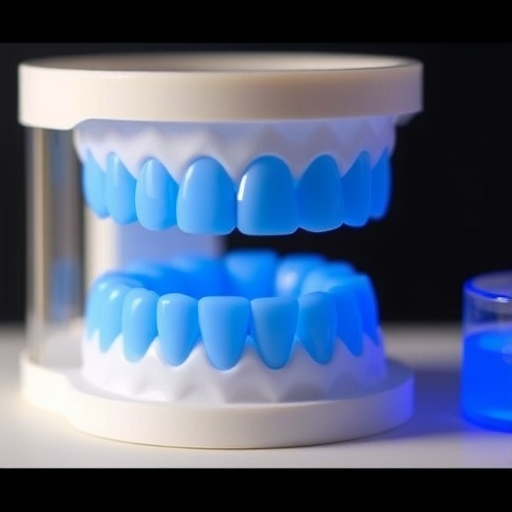Recent breakthroughs in bioprinting technology have unveiled not only the potential of portable bioprinters but also their applications in specialized fields such as dentistry. Researchers from various academic institutions are making strides in optimizing these devices, thereby pushing the boundaries of conventional medical practices. The study conducted by Chen, Kong, and Zhang outlines innovative designs of portable bioprinters and their implications for dental applications, marking a significant leap in bioprinting technology.
In recent years, bioprinting has gained traction as an advanced manufacturing method capable of producing complex biological structures. The advancements are largely attributed to the continuous development of portable bioprinters, which have streamlined the bioprinting process. Unlike traditional bioprinters that require complex setups and stationary locations, portable models offer mobility and flexibility, making them accessible for various applications, including point-of-care treatments.
Portable bioprinters are tailored to meet the specific needs of applications in dentistry, where precision and speed are paramount. The research highlights the diverse design configurations of these printers, showcasing how different engineering approaches can cater to unique requirements of dental procedures. The capability to fabricate dental implants and prosthetics on-site represents a revolutionary shift, contributing to enhanced patient outcomes and increased efficiency within dental practices.
The key advantages of utilizing portable bioprinters include reduced wait times for patients and the ability to create bespoke solutions tailored to individual needs. Traditional methods often involve lengthy processes, requiring multiple appointments for patients awaiting implant solutions. However, portable bioprinting technology significantly decreases the turnaround time, allowing dental professionals to deliver customized treatments in real time.
Bioprinting technology leverages bio-inks composed of living cells and biomaterials to create tissue-like structures. The innovations discussed in the study focus on refining bio-ink formulations to ensure optimal cell viability and functionality post-printing. The enhancement of these bio-inks is critical not only for dental applications but also for broader medical contexts, paving the way for the integration of bioprinting in tissue engineering and regenerative medicine.
Moreover, the researchers examined structural and functional aspects of the printed tissues. Their results indicated promising outcomes, including cell proliferation and matrix deposition, which are vital for successful integration in the human body. Understanding these intricate biological interactions is essential for advancing the future of personalized medicine, where treatments can be tailored to the unique physiological context of each individual.
Another fundamental aspect explored is the regulatory landscape surrounding the use of bioprinting technology in clinical settings. As the field expands, it confronts various ethical and regulatory challenges that must be navigated to ensure patient safety and product efficacy. The study underscores the importance of establishing guidelines and protocols that will facilitate the integration of these technologies into standard practice while safeguarding patient wellbeing.
The role of interdisciplinary collaboration in the advancement of portable bioprinters must not be underestimated. Engineers, biologists, and dentists must work closely to bridge the gap between technological possibilities and clinical realities. Such collaborative efforts could accelerate the development of innovative solutions that are scientifically sound and clinically relevant, leading to faster and more effective treatments for dental patients worldwide.
As the research emphasizes, the future of portable bioprinting is not merely a technological pursuit; it’s a holistic endeavor that encompasses patient care, material science, and regulatory compliance. The potential for expanding these technologies beyond dental applications is vast, opening avenues for interventions in surgical procedures, wound healing, and even organ regeneration in the long run.
Public perception and acceptance of bioprinting technologies will also play a crucial role in their adoption. Education and outreach initiatives can help inform patients about the benefits and safety of bioprinted solutions, paving the way for greater acceptance in day-to-day medical practice. As advancements are made, addressing public concerns about the technology will be essential to facilitate its integration into healthcare systems.
In conclusion, the paper by Chen, Kong, and Zhang presents a comprehensive overview of the latest advancements in portable bioprinting technology. By bridging the gap between engineering advancements and clinical needs, the research stands to revolutionize patient care in dentistry and beyond. The innovative designs and applications articulated in this study are merely the beginning of an era where portable bioprinting can redefine standards and expectations for dental treatments globally, ultimately enhancing patient experiences and healthcare outcomes.
The future is undeniably promising in the realm of bioprinting, and as researchers continue to explore the myriad possibilities that these portable devices can offer, the healthcare community remains on the cusp of a revolution that could reshape the way we understand and approach medical treatments. Equipped with the right tools, technologies, and collaborative frameworks, we are inching ever closer to a future where personalized medicine becomes the norm rather than the exception.
Subject of Research: Bioprinting Technology and Dental Applications.
Article Title: Advancing Bioprinting Technology Utilizing Portable Bioprinters: From Various Device Designs to Dental Applications.
Article References:
Chen, Y., Kong, M., Zhang, T. et al. Advancing Bioprinting Technology Utilizing Portable Bioprinters: From Various Device Designs to Dental Applications. Ann Biomed Eng (2025). https://doi.org/10.1007/s10439-025-03789-w
Image Credits: AI Generated
DOI: 10.1007/s10439-025-03789-w
Keywords: Bioprinting, Portable Bioprinters, Dental Applications, Bio-inks, Personalized Medicine.




